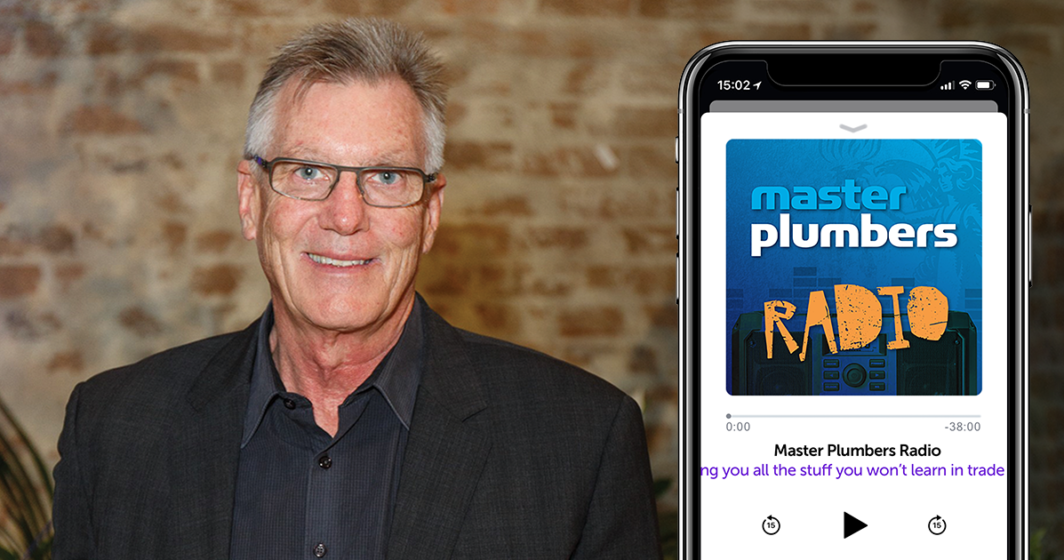A pioneer in sustainable design and research, Dr Steve Cummings has dedicated himself to developing products that minimise water consumption.
He’s recognised internationally as an authority in this field, is an associate of the Institute of Sustainable Futures and collaborates in Australia and internationally with universities, industry experts, governments and standards representatives. He recently spoke with Daniel Carroll on Master Plumbers Radio.

DANIEL You’ve been involved in design for more than 40 years. How did it all start?
STEVE I started in the industry in 1976 when I joined Doulton Australia in designing sanitaryware. I became chief designer there before I moved on to Caroma, who took over Doulton.
DANIEL There’s no doubt been significant development in the time since you started. What would be some of the challenges that you’ve faced in your time?
STEVE When I started, my expectations of what we should be doing was limited by our capability of doing it, and that was in manufacturing. So, concurrently with the development of what we were doing, we were then increasing our capacity to develop the products that made us competitive internationally.
DANIEL Can you share a little bit about the importance of good design and how that contributes to delivering more efficient products?
STEVE If I go back to the work we did originally on dual flush, in the early ‘80s when we released it, we were flushing with 11 litres for the full flush. We moved to dual flush, which made 11 and five and a half. Then, I went on a journey to investigate further reductions in water use and started to look at the toilet pans and what we could do there. The limitation on the performance of the cistern was the pan. You had the cistern that can drop the water, but you had to actually do things in the pan, so once you start reducing the water going into the pan, then you had to really look at the pan design. In 1993, we released the 6/3, which was a total redesign of the pan and cistern.
DANIEL The dual flush toilet is a great example of evolutionary production. Can you share some of the experience in designing and developing a product that’s constantly evolving?
STEVE The thinking comes locally, but it’s influenced by what’s going on overseas. The latest evolution of the toilet pan, for us, was the Cleanflush where we eliminated the rim with the cistern to make it easier to clean, and we did a lot of work on the flushing technology around to make sure that we didn’t lose the efficiency. We saw the trend coming from overseas, in Europe mainly, then we looked at what we could do to make it fit with our system and provide the flushing performance that was to be expected. We didn’t want to reduce the flushing performance of the product, so we spent a considerable amount of time in researching and getting the cistern operating correctly so that it gives us the similar flush performance to what we’ve been used to.
DANIEL The quality of the items that we use in the construction industry is always in focus, and more so in plumbing over the last few years with the introduction of the WaterMark scheme in Australia. I believe you were part of the group that was responsible for the implementation of that scheme. How important is it that a scheme like this exists?
STEVE Well, I think for products that can affect the public health and safety of Australians, it really needs to be regulated and come under a scheme like the WaterMark scheme. Other major economies around the world have got regulation to varying extent, some are highly regulated, some are not so much, but I think it’s just fundamental for the industry that we’ve got a product that we can trust in with the WaterMark name on it. We know that it’s been tested and developed correctly and is meeting the requirements for Australia.
DANIEL What does the future hold, do you think, in the plumbing industry and the design of products?
STEVE I’m a believer of using the gravity to flush the system and operate the systems. Vacuum systems have got their place and they’ll be used in varying areas where there’s issues, but I think, overall, the system will remain gravity. Maybe assisted by some special technologies that will come. I see the digitalisation of the plumbing industry is going to be widespread. We’re going to get a lot of data coming from the sensors that we’ll be using throughout the plumbing systems. From the data, we’ll be able to make valuable decisions on things that we don’t know about now, which is exciting, I think.
DANIEL As you know Master Plumbers has introduced Continuing Professional Development for its members and the wider plumbing community to help keep up to speed with what’s happening in the industry and keep yourself fresh. How do you stay up to date with what you do?
STEVE Well, I’m regularly going overseas to industry exhibitions, conferences, and talking to overseas suppliers that have got knowledge of the developments that are in place internationally. So I think I’m right up to speed with what’s happening internationally. Don’t underestimate the work that we’re doing in Australia, either. It’s internationally competitive, and I think we’re in the forefront as well. I’m looking for opportunities, what can we do, how can we be better, how can we be as good as them or better, rather than when I first started going, where they were so far in front of us in the ‘70s and ‘80s, it wasn’t funny.
DANIEL Do you find people, at an international level, coming back to Australia to see what we’re doing and use the knowledge of the people here to influence what they’re doing abroad?
STEVE I think we’ve got a lot of respect in Australia for what we do. There’s a quality element of how we look at things, we like things to perform well and be able to be serviced well. That’s general across the industry, I think the good guys in the industry are really making great products, and I think that’s taken up by the suppliers because they know that it’s difficult to come in with products that aren’t competitive to the products available here.
Dr Steve Cummings is a renowned industrial designer and fellow of The Design Institute of Australia. He was inducted into the Design Institute of Australia’s Hall of Fame in 2012, and since has held senior appointments in the bathroom product design industry and has had a longstanding participation in standards development in Australia and internationally since 1981.
You can listen to the full podcast here or by searching for Master Plumbers Radio on Google, Apple Podcasts or Spotify.
Share this Article






